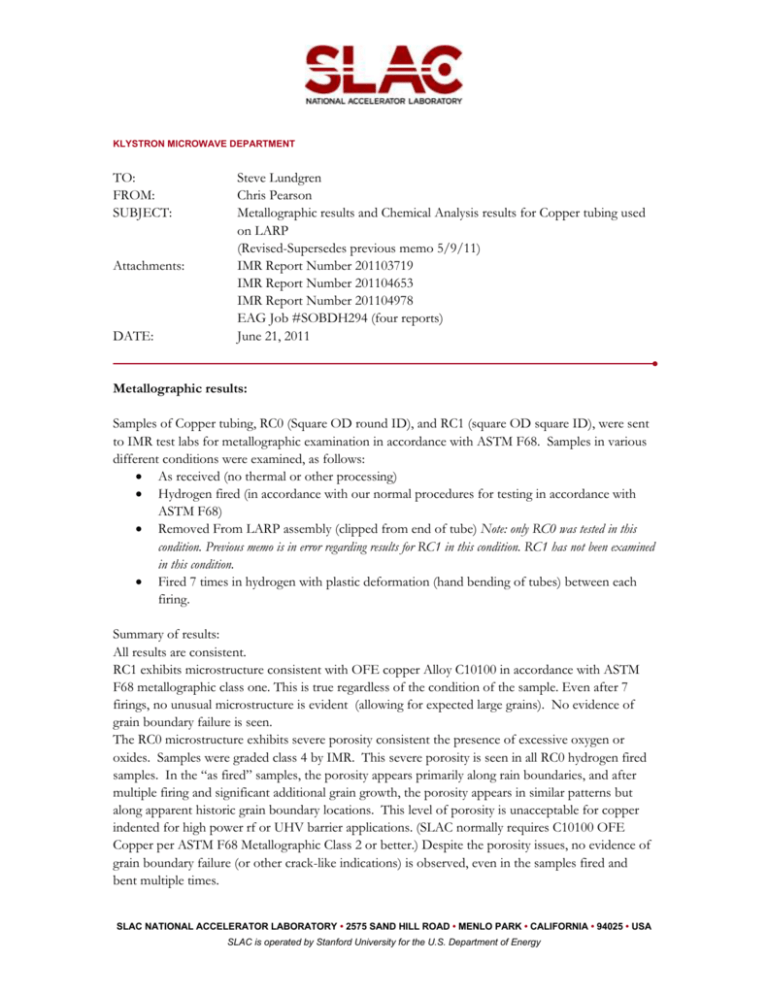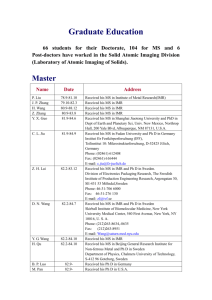LARP copper met rev 1 - SLAC Project
advertisement

KLYSTRON MICROWAVE DEPARTMENT TO: FROM: SUBJECT: Attachments: DATE: Steve Lundgren Chris Pearson Metallographic results and Chemical Analysis results for Copper tubing used on LARP (Revised-Supersedes previous memo 5/9/11) IMR Report Number 201103719 IMR Report Number 201104653 IMR Report Number 201104978 EAG Job #SOBDH294 (four reports) June 21, 2011 Metallographic results: Samples of Copper tubing, RC0 (Square OD round ID), and RC1 (square OD square ID), were sent to IMR test labs for metallographic examination in accordance with ASTM F68. Samples in various different conditions were examined, as follows: As received (no thermal or other processing) Hydrogen fired (in accordance with our normal procedures for testing in accordance with ASTM F68) Removed From LARP assembly (clipped from end of tube) Note: only RC0 was tested in this condition. Previous memo is in error regarding results for RC1 in this condition. RC1 has not been examined in this condition. Fired 7 times in hydrogen with plastic deformation (hand bending of tubes) between each firing. Summary of results: All results are consistent. RC1 exhibits microstructure consistent with OFE copper Alloy C10100 in accordance with ASTM F68 metallographic class one. This is true regardless of the condition of the sample. Even after 7 firings, no unusual microstructure is evident (allowing for expected large grains). No evidence of grain boundary failure is seen. The RC0 microstructure exhibits severe porosity consistent the presence of excessive oxygen or oxides. Samples were graded class 4 by IMR. This severe porosity is seen in all RC0 hydrogen fired samples. In the “as fired” samples, the porosity appears primarily along rain boundaries, and after multiple firing and significant additional grain growth, the porosity appears in similar patterns but along apparent historic grain boundary locations. This level of porosity is unacceptable for copper indented for high power rf or UHV barrier applications. (SLAC normally requires C10100 OFE Copper per ASTM F68 Metallographic Class 2 or better.) Despite the porosity issues, no evidence of grain boundary failure (or other crack-like indications) is observed, even in the samples fired and bent multiple times. SLAC NATIONAL ACCELERATOR LABORATORY • 2575 SAND HILL ROAD • MENLO PARK • CALIFORNIA • 94025 • USA SLAC is operated by Stanford University for the U.S. Department of Energy See attached IMR reports: IMR Report Number 201103719, May 4, 2011: RCO samples removed from LARP structure. (Note: In this report, all references to RC1 are in error. All samples tested at this time were RC0) IMR Report Number 201104653, June 3, 2011: RCO and RC1 in as received and as fired condition. IMR Report Number 201104978, June 14, 2011: RCO and RC1 samples fired and bent 7 times. Chemical Analysis Results: Samples of Copper tubing, RC0 (Square OD round ID), and RC1 (square OD square ID), were sent to EAG (Syracuse) for GDMS (Glow Discharge Mass Spectroscopy) for 25 elements of interest, and IGA (Instrumental Gas Analysis) for Oxygen. Summary of results: There are no significant findings. The results are typical for alloy C10100 copper. The oxygen content for both samples are within (or very close to) the normal range. This may seem to be somewhat surprising since we might expect to find higher oxygen in the RC0 sample. However, as I noted in our previous conversations, quantitative analysis for oxygen in copper at levels in the 10 ppm range is very difficult. I do not have confidence the accuracy of these results. In the RC1 sample the phosphorus content slightly exceeds the F-68 specification, 3.6 ppm vs 3.0. Phosphorus is sometimes used as a deoxidizer in copper, but at this level, I doubt that this finding has any significance. See attached EAG reports: EAG Job #SOBDH294, June 13-14, 2011 (four reports) As we have discussed, we still plan on doing some metallography on samples which been exposed to sustained stress at temperature. Perhaps these tests will provide some interesting results. SLAC NATIONAL ACCELERATOR LABORATORY • 2575 SAND HILL ROAD • MENLO PARK • CALIFORNIA • 94025 • USA SLAC is operated by Stanford University for the U.S. Department of Energy





